by Cirecie West-Olatunji, Ph.D., University of Florida
Earcos Teachers Conference, 2010, Manila, Philippines
(These session notes are the words of the speaker, in some cases, paraphrased, and others, quoted.)
The aim of this workshop was to provide us as teachers with new skills for partnering with parents. She asked, "What are your current challenges to partnering with parents?" We answered with things like:
- no adequate, easy-to-use systems in place at school
- wrong email or phone number information for parents
- parents traveling a lot
- not knowing when and how to approach the parents
- parents not understanding the programme/assessment at school
- desire to deal with student first, parent as a last resort
- some parents view contact as negative; "My child is in trouble"
- parents are unwilling to self-reflect or change
- teacher colleague parents and friends of teacher who are parents
- finding time to meet
- western values colliding with other culture expectations
- parents not being accessible in general; lack of time, for ex.
- low level of parent education
- really bad home life for the students
- parents who have high expecations for kids but aren't willing to take the time to help them
- language differences
- differences in values
- parents who say they know what's best for their child
Socioeconomic status [SES] is NOT always a factor in these problems. We need to partner with kids, value what they know and then use that. We need to start every interaction with the assumption that they
want to be involved and engaged. Even with parents who come in very bossy, evidence shows that this may mean they actually are NOT confident about what to do. So address the fear first. Explain the procedures and protocols and what happens next.
As a parent it is so hard to feel blamed for our children's shortcomings. This can lead to resistance and reluctance to partner with teachers in collaboration, especially if the family has had previous negative school experiences - they've got baggage! Our goal is to get the parent to see us as an advocate for their child. The parent-teacher relationship needs to be like a parental bond - they have to be on the same page even when they disagree, present a united front - otherwise, the student/child will drive a wedge between the parents and teachers.
When someone speaks with a particular pitch or with gestures, it is often assumed that the person is agitated or angry; rarely is it conceived that there night be a misinterpretation of behavior because of culturally embedded norms. What we are saying isn't being communicated, and what we're hearing isn't what's being said! Silence is a useful tool; wait to hear what parents have to say. We can't be afraid to interact with people because we don't understand them. This is where recovery skills come in. Don't be afraid to apologize, and be willing to start over.
70% of what we do should be PREVENTION.
Families should be seen as
experts in their children's development and educational needs and thus significant partners in children's education.
Funds of knowledge (Moll and Gonzalez): People are not empty vessels. Students and parents come to us with funds of knowledge, and we are most effective when we assume that they have that knowledge and are willing to work with that. We need to think about the way they've socialized their children, particularly in a cultural context. Acculturative stress occurs when the child's home culture collides with the culture of the school. However, the new literature shows that children can and do deal with this stress very well, if we give them the tools.
Family involvement is not just volunteering at a school event or signing a planner, but is a two-way sharing of information that engages families. A caregiver may never set foot in the school and yet still be involved. Unlike traditional "parent involvement" activities that emphasize passive support roles for parents, home-swchool collaboration views education as a shared responsibility in which families and educators develop shared goals and plans that support the success of all students. As teachers, we are challenged to think of new, nontraditional ways of involving parents.
3 questions for parents: Ask them what their schools and families did that helped them! Then you can ask them, "OK, tell me how you're doing that with your child." How can I help? That is partnering with parents. It's empowering, culturally responsive, and it's collaborative.
By focusing on what students' families think, value, and do, it validates and honors differences that exist and brings multiple dimensions of students' lived experinces into the classrom. Understanding students' families can enable teachers to create lesson plans based in students' existing skills and competencies. As a result,
students become more engaged and successful, teachers learn from families, and families engage more in their children's education in and out of school.
FIVE STEPS
- Educate yourself about community/family history.
- Increase self-awareness about your biases.
- Respect parents' funds of knowledge.
- Ask questions instead of assuming.
- Seek parnerships.


